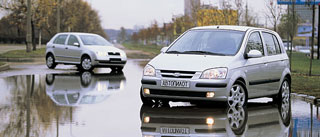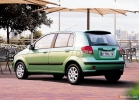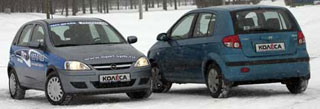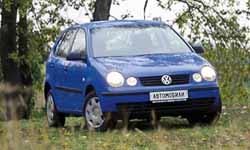Hyundai Getz test drive 5 doors 2002 - 2005 hatchback
How to become big
 The usual formula is a small large car can be sold completely differently. It is enough to compare Skoda Fabia with Hyundai Getz.
The usual formula is a small large car can be sold completely differently. It is enough to compare Skoda Fabia with Hyundai Getz. One of the main disadvantages of modern automotive, professionals and lovers always call the similarity to each other models from different manufacturers. However, if you look closely at the cars, it turns out that this is not so bad. For example, the latest Hyundai Getz model according to the description is a typical representative of his class. If we compare it with one of the most popular models of the same segment with us - Skoda Fabia, then it turns out almost the same thing: MacPherson ahead, half -dependent behind, front -wheel drive, four -cylinder engine ... Nevertheless, a personal acquaintance made it once again Recall such concepts as school and traditions.
 Some people love hotter. Take at least the characteristics of the engine. Hyundai, like other Korean manufacturers, prefers to configure its motors for the maximum return. So on the expensive version, the 1.6 liter engine develops 105 hp. A more modest option with a 1.3-liter power unit pleasantly surprises with a capacity of 82 hp. For the test, we took the most expensive version with the most powerful engine and automatic transmission - this is how the opportunity to evaluate all possible bells and whistles. Fabia with the most powerful of the motors offered to him approached him - 101 hp. By the way, here Skoda (more precisely, Volkswagen - this engine is produced in Germany) surpassed the Far Eastern competitors: this capacity is removed from the volume of 1390 cubic meters. See, however, I had to go to some kind of violation of equality and agree to a mechanical transmission, because the machine on Fabia is combined exclusively with a 75-horsepower engine. And in this version, the loss in dynamics will be too obvious. But at a price, both of our cars are close enough, according to the price list Fabia Comfort 1.6 16V costs 13,130 euros (at the rate at the time of the test-almost the same amount of dollars), and the Hyundai Getz 1.6 with mechanics-$ 13,490. The automatic transmission added to its value of 1.2 thousand conditional units.
Some people love hotter. Take at least the characteristics of the engine. Hyundai, like other Korean manufacturers, prefers to configure its motors for the maximum return. So on the expensive version, the 1.6 liter engine develops 105 hp. A more modest option with a 1.3-liter power unit pleasantly surprises with a capacity of 82 hp. For the test, we took the most expensive version with the most powerful engine and automatic transmission - this is how the opportunity to evaluate all possible bells and whistles. Fabia with the most powerful of the motors offered to him approached him - 101 hp. By the way, here Skoda (more precisely, Volkswagen - this engine is produced in Germany) surpassed the Far Eastern competitors: this capacity is removed from the volume of 1390 cubic meters. See, however, I had to go to some kind of violation of equality and agree to a mechanical transmission, because the machine on Fabia is combined exclusively with a 75-horsepower engine. And in this version, the loss in dynamics will be too obvious. But at a price, both of our cars are close enough, according to the price list Fabia Comfort 1.6 16V costs 13,130 euros (at the rate at the time of the test-almost the same amount of dollars), and the Hyundai Getz 1.6 with mechanics-$ 13,490. The automatic transmission added to its value of 1.2 thousand conditional units. In terms of configuration, both cars are also close to the maximum ... more precisely, Getz is packed as much as possible, but Fabia looks a little more modest: for example, there is no air conditioner, fog heads, electric windows are only ahead, stamped disks instead of cast on Hyundai ... in general, At first glance, the difference in prices is not the benefit of Skoda. However, a closer acquaintance forced to soften the position.
GROWING PAINS. Cars are close in size, however, they can serve as an example of a different approach to the design of a compact car. Getz is 150 mm shorter, but higher by 40. For such dimensions, the difference is, in general, significant. As a result, the Korean can already be considered a kind of minivan-the landing of the driver and passengers in it is more vertical. Fabia is also not the lowest car in the world - at least it is even higher than the 20 mm older sister Octavia and does not reach Superb as much. However, the position of the driver in our European guest is quite passenger.
 A fundamentally different approach is noticeable in design: Hyundai, if there are no other cars and people next to it, is perceived more than it really is. This is a well -known and fairly common technique of visual increasing. In this case, not only the choice of proportions, but also many small parts of the surface work on it. But Skoda is quite frank in terms of its size: they say, a little I, but roomy. Its shape is more restrained and almost devoid of decorative elements.
A fundamentally different approach is noticeable in design: Hyundai, if there are no other cars and people next to it, is perceived more than it really is. This is a well -known and fairly common technique of visual increasing. In this case, not only the choice of proportions, but also many small parts of the surface work on it. But Skoda is quite frank in terms of its size: they say, a little I, but roomy. Its shape is more restrained and almost devoid of decorative elements. Better less, but better? Inside, the impression of appearance finds a completely adequate response: elegant and even aggressive forms of Getz and neat surfaces of Fabia represent two equally modern and fashionable approaches to interior design. True, with closer contact, it turns out that the dashboard in Hyundai is made of hard plastic, and the inconsistency of the texture and color of the panel and linings on the doors can be seen with the naked eye. Skoda also has a difference, but less noticeable, and it arose more reasonably - the panel is made of soft plastic, and the elements of the doors are made of cheaper, hard.
Another example of the difference in Asian and European approaches is the central castle. Firstly, Getz has remote control from the button with the key. There is also a button on the Fabia key, only it is designed to turn on the light bulb mounted in it. Comfortable? Certainly. In addition, it should be borne in mind that almost all buyers have anti -theft systems on us in which there are remote control. But still, you see, there is a difference. Secondly, when opening the locked doors from the inside, to unlock Fabia locks, it is enough to pull the handle twice. Getz, like most Japanese and Korean machines, has a simpler system - first you need to press the lock key. Little things? Undoubtedly. But often it is in them that the difference in the thinking of designers and marketers is visible.
Let's look into the trunk. At Getz, it is two -story - at the threshold level there is a regiment that can be folded and used the entire volume. The backs of the rear seats, if they are thrown back, form an almost even surface with this shelf. There is an opportunity to fold the seats completely, then the volume of the trunk will reach 987 liters. Fabia offers fewer options, and it is not possible to steal a flat surface when folding the rear seat. But she has a full -sized spare wheel. And again, let's pay attention to the details: the upper shelf of Hyundai is just a formed panel, and Skoda has a much more rigid volumetric design. Well, a small example of the thoroughness of the Czechs: the trunk lock of the trunk castle is put on a bright plastic case protruding from the end of the door. His only purpose is to make the castle more noticeable and reduce the likelihood of a blow to him ...
 For friendly neighing ... The wrong choice of transmission was partly justified from the point of view of the dynamics of acceleration, in terms of a set of 100 km/h from the place of the machine, and according to manufacturers, and according to our impressions, extremely close to each other. Of course, Getz shows the maximum dynamics only in Kik-Dawn mode, but it is worth noting that it reacts quite clearly to the pressing of the pedal-the box practically does not think. So demonstrating to others your sports approach to life is very simple. On Moscow streets, both cars will allow you to leave the traffic lights quickly enough. They are also united by the fact that the motors when moving in dynamic mode do not allow themselves to forget about themselves: almost silent at idle, after 2.5-3 thousand they growl joyfully. The sound level is quite acceptable, and the timbre is even pleasant - there is no compassionate feeling that the engine is spinning from the last strength.
For friendly neighing ... The wrong choice of transmission was partly justified from the point of view of the dynamics of acceleration, in terms of a set of 100 km/h from the place of the machine, and according to manufacturers, and according to our impressions, extremely close to each other. Of course, Getz shows the maximum dynamics only in Kik-Dawn mode, but it is worth noting that it reacts quite clearly to the pressing of the pedal-the box practically does not think. So demonstrating to others your sports approach to life is very simple. On Moscow streets, both cars will allow you to leave the traffic lights quickly enough. They are also united by the fact that the motors when moving in dynamic mode do not allow themselves to forget about themselves: almost silent at idle, after 2.5-3 thousand they growl joyfully. The sound level is quite acceptable, and the timbre is even pleasant - there is no compassionate feeling that the engine is spinning from the last strength. The Fabia engine seemed somewhat incomprehensible to us: it somehow deals and too smoothly reacts to the pressing and release of the pedal. Apparently, the tuning of the electronic drive of the accelerator affects here. The clutch pedal in the Czech car is also too long -term, grasps too high - almost only when the pedal is already released. This, however, is characteristic of many foreign cars. But the shift drive in Fabia is close to the ideal.
Getz has an engine reaction to the pressing of the accelerator is almost instant and accurate. The brakes were very good on both cars. Effective (especially in Fabia, where all the brakes are disk), on the one hand, and at the same time predictable, on the other hand, the exact dosage of effort does not require addiction. Maybe Fabia is a little better here, but the difference is quite possible even for cars of the same model.
In different ways, these cars perceive our roads. Getz practically does not notice minor irregularities, but he is noticeably shocking on serious ones. Fabia swallows holes with greater ease, but at the same time he extinguishes vibration on the cobblestone worse.
As you can see, even almost the same cars can differ markedly.
Text Valery Chusov, photo Alexey Ilyin
Source: "Autopilot"
Video test drives Hyundai Getz 5 doors 2002 - 2005
Hyundai Getz test drives 5 doors 2002 - 2005
Hyundai Getz Crash Test 5 Doors 2002 - 2005
Krassh Test: Detailed Information25%
Driver and passengers
5%
Pedestrians
37%
Passenger children
Hyundai Getz 5 doors 2002 - 2005
Hyundai Getz faults 5 doors: Detailed information| Getz 5 doors 2002 - 2005 | |
|---|---|
| Engine |  |
| Transmission |  |
| Control system and suspension |  |
| Brake system |  |
| Air heating and air conditioning |  |
| Launch and charging system |  |
| Electric components and so on |  |
| Corrosion body stability |  |










